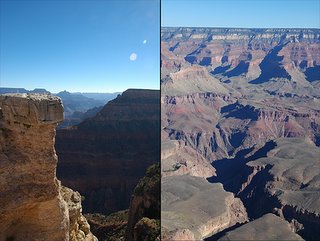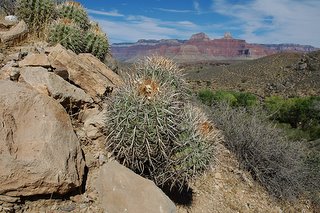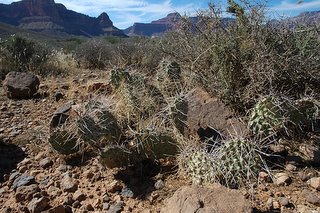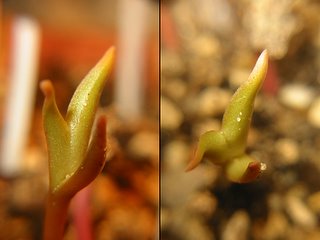Heading north on Arizona state route 64 from Williams, AZ and driving through Kaibab National Forest, it’s hard to imagine the earth split wide open. When you are standing at the Grand Canyon rim you have to acknowledge that your imagination not always suffices.

View from Mather Point
I went down the canyon, following the Bright Angel Trail to Plateau Point. On the upper part of the trail the cactus vegetation was rather sparse, but after having passed the Indian Gardens and entered the Blackbrush (Coleogyne ramosissima) dominated desertscrub on the Tonto Platform, the cacti became abundant.

Echinocactus polycephalus overlooks the Tonto Platform
Especially Opuntias are massively present, almost covering the ground in some areas. I collected some Opuntia polyacantha var. hystricina seeds (thanks to the friendly people at the cacti_etc mailing list for helping me getting the name correct). The seed donor is depicted below.

Opuntia polyacantha var. hystricina
I’m aware that it’s absolutely stupid to sow cactus seeds at this time of year (in the Northern Hemisphere, that is ;-), but I couldn’t resist the temptation of testing the viability of the seeds. Prior to sowing I soaked the seeds for 14 days and after an additional two weeks in the ground 50% of the seeds have now germinated. I expected the seedlings to be “leggy” but was a bit surprised to see what looks like a tricotyledon?

Tricotyledon Opuntia seedling
The Grand Canyon hike took place September 24, 2005. Additional photos can be found at Grand Canyon Cacti & Succulents.
Malpighia 1927 v.30 (added: 11/24/2025)
-
*By:*
Borzi, Antonino,1852-1921.
Penzig, O.1856-1929.
Pirotta, Romualdo,1853-1936.
*Publication Info:*
Messina : g. Capra & co., 1887-89 ; Genova : Tip. di A...
1 month ago


















